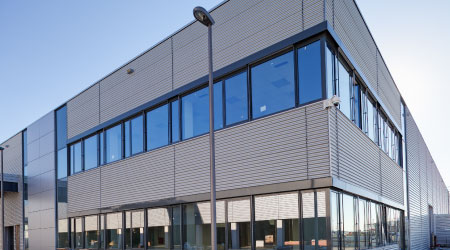Roofs at the Green Frontier
SPECIAL REPORT PREPARED FOR THE CENTER FOR ENVIRONMENTAL IN ROOFING
The latest iteration of the U.S. Green Building Council’s LEED system, LEED 2009 version 3, has re-weighted credits to prioritize strategies that will have the most effect on addressing climate change by increasing energy efficiency and reducing carbon dioxide emissions.
LEED serves as a framework for facility executives to consider ways building systems like the roof can contribute to green initiatives. In North America, 4 billion square feet of commercial roofs is installed annually, according to Tegnos Research. Of that, 75 percent is re-roofing work.
While it isn’t possible to use LEED to certify the roof by itself, several strategies can make the roof do more work than just keeping the floors dry. And while these steps might not be as simple as swapping out light bulbs, their benefits are long-lasting and often hard to dispute.
Among building systems, the roof is a rarity in being able to play both in the renewable energy sector as a platform for photovoltaics or microturbines while also fitting into the energy efficiency sector, says Craig Silvertooth, executive director of the Center for Environmental Innovation in Roofing (CEIR). LEED focuses on both of these areas. In addition, the roof can support other green principles, such as stormwater management and reducing the urban heat island effect, and lends itself to significant recycling at end of life.
Some project teams have misused the LEED system in the past, adopting strategies on the basis of possible points rather than striving for an integrated design. The point-picking approach will especially not work with the roof, but thoughtfully considering how the roof can support the concepts underpinning LEED will pay off.
LEED Principle: The Roof and Energy Efficiency
The roof can be a very effective vehicle for achieving greenhouse gas emissions reduction goals, says James Hoff, CEIR research director and president of Tegnos Research. Even under the best scenarios, alternative energy sources, such as solar and wind, will only be able to meet about 25 percent of energy needs, he says. Meeting emissions targets will require significant increases in energy efficiency. And that’s where the roof could be a star.
The bulk of building-related greenhouse gas emissions, on the order of 80 percent, come from operations — the energy required to heat and cool and light the building. The other 20 percent is associated with the embodied energy expended to extract the raw materials, manufacture the building materials, assemble the building, and maintain the building over its service life.
“If all of the commercial roofs in the United States were upgraded to a level approximately 20 percent above the baseline within LEED, the savings would exceed 47 million metric tons of carbon dioxide emissions annually,” Hoff says. One major way to achieve those savings is by increasing the roof’s R-value. Increased roof insulation dampens energy transfer through the roof, decreasing cooling and heating loads.
The roof is responsible for about 15 to 20 percent of the building’s energy load, Hoff says. By increasing its insulation, facility executives can make sure the roof pulls its weight in meeting energy efficiency goals so that other building systems don’t have to compensate for it. For example, to achieve a whole-building energy reduction of 10 percent over ASHRAE 90.1-2007, the minimum required by LEED 2009, the proportional roof R-value would be 22.2 in ASHRAE climate zones 2 through 5. To achieve a 20 percent energy savings, the R-value for the same region would be 25.
Increased insulation leading to increased energy efficiency and savings is not breaking news. But most commercial buildings in the United States are nevertheless under-insulated. “In low-rise buildings, the majority of the energy is lost through the roof,” Silvertooth says. “We need to do a better job of insulating on the front end.”
However, as with any decision affecting a building system, insulation values for the roof cannot be decided in a vacuum. There is a point of diminishing returns, so the appropriate level of insulation depends on myriad factors, such as building use and location.
Another option for increasing the R-value of a roof is to install a vegetative roof. The thickness of the planting medium provides the bulk of the benefit. The extra weight of a vegetative roof puts this option out of reach for some facilities, but the benefits that can come from this roofing strategy make it worth some consideration.
The 4 Billion-Square-Foot Gorilla
Even though roofs are one the largest building systems, they have historically been nearly invisible when it comes to green initiatives.
“The roof has not been viewed as a strategic asset or platform,” says Craig Silvertooth, executive director of the Center for Environmental Innovation in Roofing (CEIR). “It’s still a small percentage of buildings that are embracing energy efficiency in the roof.”
There are several reasons for this. Green building programs, such as LEED, have primarily focused on new construction, leaving existing roofs unaddressed. And even when the roof is mentioned as part of a larger energy efficiency strategy in a green building model, the roof-specific language is often buried and easy to overlook.
To top it all off, the current financial environment is making building owners hesitant to reach for a more energy-efficient roof, says Silvertooth.
But a change in perception of the roof’s role is coming.
“In the design phase, any architecture firm of stature is considering it,” says Richard Nugent, Nations Roof CEO. “It might not be for a LEED certification, but for anticipating an eventual issue, like accounting for their carbon footprint.”
Government mandates, building codes and CFOs suddenly paying more attention to the cost of energy are also driving the market, as well as attitudes toward social and corporate responsibility.
|
Related Topics:















